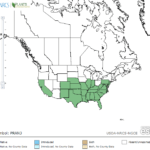Wild Plum - All 15 wild plum trees of North America
Fifteen wild plum trees grow in North America! Wild Plum trees are our native treasures, and they grow native in all US States. They grow in hot and cold climates. Wild Plums are highly adaptable, more disease resistant and more drought tolerant than cultivated varieties. The difference between Wild and Cultivated plum trees is simple. One is a specialist and one is grown for food 😉 All 15 trees are listed below.
Wild plum trees fit any need! Beach Plum trees grow in … sand dunes but also grows in good soil! Most varieties can be used to create fence, hedge, windbreak, or to control erosion. Or, the Hortulan and Mexican Plum trees make an ideal single accent tree. Some Wild Plum trees are very rare and some grow everywhere. Some are tall and some short; some grow in FRIGID weather and other do not. A list of the Best, Worst and Weirdest of 15 Wild Plum Trees is below!
Grow wild plum trees! some are at risk of decline, such as the Allegheny Plum. Invasive species overtake wild plum tree habitat. Also, seed dispersing mammals such as bear — the ideal “disperser” — have declined in ecosystems.
Finally, they grow naturally in all plant zones! And wildlife and pollinators thrive on wild plum trees.
Click here for our compressive Plum Tree Guide. The Guide shows all types of plum trees, care and maintenance, fact sheet, use in landscaping, recipes, propagate, and MORE! 😉
And, check-out our list of 400 edible plants!
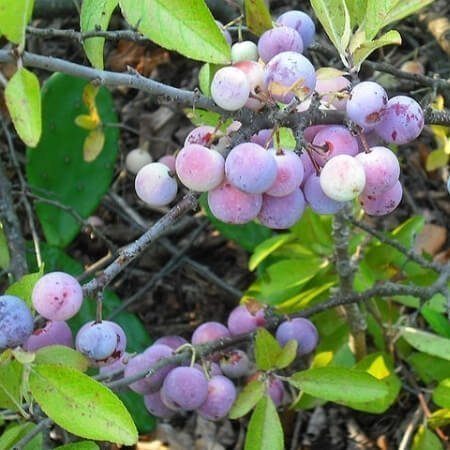
credit: Aznaturalist via Wikipedia
As an Amazon Associate, HEPPY earns from qualifying purchases (paid link).
Here’s a list of all the products we truly use and trust.
What's the difference: Wild Plum vs. "Cultivar" Plum Trees?
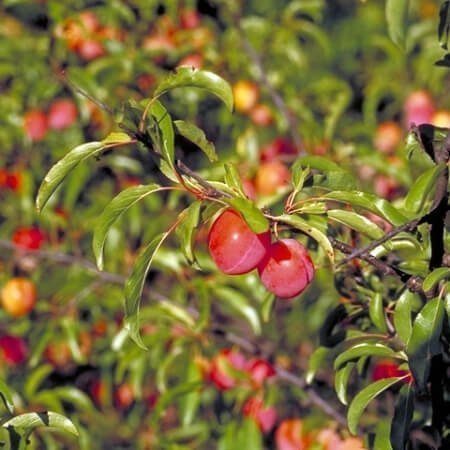
Cultivar Plum trees
“Cultivar” Plum trees are domesticated plants. There are as many as 6,000 cultivars — 6,000 different Plum trees bred to produce specific characteristics.
They produce the fruit we buy in a store. In-store varieties include the Imperial, Italian, Jefferson, Mirabelles, Santa Rosa, Satsuma, Black Beauty, Elephant Heart, Friar, and Mariposa. Nurseries sell cultivars Plum trees. Rarely do nurseries sell wild Plum trees.
Almost all cultivar Plum trees are categorized as European plums or Japanese plums. However, China is the origin of Japanese plums. The Japanese have cultivated the Plum tree for 2,000 years. Going further back, remains of Plum have been found in Neolithic-age archaeological sites (back 10,000 years!).
Wild Plum trees
On the other hand, wild plum trees are specialists. They are more adaptable, and fill many environmental niches that cultivars do not. And, they produce fruit!
Wild Plum strengths
Wild plum trees are more disease resistant and adaptable to more soils. They require FAR less water and tolerate shade better. They are grown as a hedgerow, on a fence line, and used for erosion control. Or, grow them for their blooms! Wild Plum trees make a great companion plant for Pawpaw trees!
Unlike cultivars, all wild plum trees are self-pollinating (except the Beach Plum)! Their flowers are hermaphrodite — flowers have organs from the male (stamens) and female & carpels). Flowers are pollinated by pollinators such as honeybees, bumblebees, butterflies, moths, flies, and wasps.
All wild plum trees “sucker” (except for the Mexican Plum). “Suckering” is when the tree’s roots push new shoots to the surface, which then develops into a new tree! Suckering is ideal for erosion control, creating a hedge, fence line, windbreak, etc. Don’t want suckers? Then remove them and develop a single trunked tree or single bush.
These plum trees grow wild in all US States. Some are very rare and grow in very specific regions. For example, the American Plum tree grows wild in 43 states! And, at least 19 Native American Indian tribes use/used the American Plum Tree for food and medicine (Native American Ethnobotany). On the other hand, the Havard’s, Murray’s Plum, and Peachbush Plum trees grow in very specific regions (all in Texas!).
Wild Plum weaknesses
Unlike cultivars, wild plum fruit are smaller, not as sweet, and flavors vary.
Wild plum fruit flavor is highly variable within the same species. For example, fruit from a particular American Plum tree may be sweet while another American Plum tree produces a tart fruit 🙁 This is wear graphing scion is important :). Also, fruit size is much smaller.
Below is our description of all 15 wild plum trees!
Best, Worst and Weirdest of 15 Wild Plum Trees
Shortest: 3′ — Peachbush Plum
Tallest: 30′ — Hortulan Plum
Smallest Fruit: 1/4 – 1/2″ — Chickasaw Plum
Largest Fruit: 1 1/4″ — Wild Goose Plum
Coldest range: zone 1 — Canadian Plum
Warmest range: zone 10 — Creek Plum
Most Tasty Fruit: Klamath and Wild Goose Plum
Least Tasty Fruit: Creek plum (I read no positive remarks about fruit’s flavor)
Most Rare: Murray’s Plum (rarely seen!)
Least Rare: American Plum (native in 43 US States!)
Wild Plum trees growing at HEPPY™: American | Beach | Chickasaw | Creek | Mexican
As an Amazon Associate, HEPPY earns from qualifying purchases (paid link).
All 15 Wild Plum Trees of North America
1. Allegheny Plum, Prunus alleghaniensis
the Allegheny Plum tree is also known as the Davis’ Plum and Sloe Plum tree.
it grows wild in the Appalachian Mountains from New York to Tennessee and North Carolina, plus throughout Michigan.
it is a ‘plant of concern’ due to several issues. Allegheny Plum tree challenges include loss of habitat, reduced number of large mammals to disperse seeds, and competition with invasive plants such as the Bush Honeysuckle (Lonicera maackii), Autumn Olive (Elaeagnus umbellata).
Height: 10-15′
Fruit size: 1/2 to 3/4″
Grow As: best as a shrub/hedge. single trunk is possible.
Plant zone: 4-8
Remarks: a difficult-to-find tree (for sale, trade, scion); very shade tolerant; the Allegheny Plum tree is characterized by the persistence of dead, thorny blackish branches.
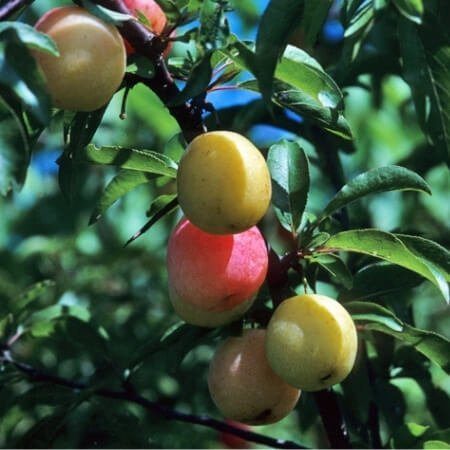
(this is a general pic; pics online are likely NOT Allegheny Plum)
As an Amazon Associate, HEPPY earns from qualifying purchases (paid link).
2. American Plum, Prunus americana
the American Plum is also known as the American Wild Plum and Wild Plum.
it’s wild, native plant in 43 US States! this wild beauty is everywhere. at least 19 Native American tribes use/used the American Plum Tree for food and medicine.
it grows with wide-spreading branches; excellent source of wildlife food and shelter; and is used as windbreak, hedge, soil erosion control. also, it’s very hardy. one landowner mentioned using a brush hog over Prunus Americana, and the plant ‘just kept growing back.’
Height: 15-20′
Fruit size: about 1″
Grow As: shrub/hedge or single trunk tree
Plant zone: 3-8
Remarks: prolific tree; erosion control, natural fencing/hedgerow; shade tolerant; excellent wildlife refuge and food source.
3. Beach Plum, Prunus maritima
the Beach Plum tree is also known as the Seaside Plum, Sand Plum and Graves’ Plum tree.
the Beach Plum tree is truly a specialist. it grows wild ON BEACHES. beaches are a sparse, unforgiving environment. this multi-stemmed shrub in found on mature dune systems of the Mid-Atlantic coastal region, and along inland tidewater streamsides. it tolerates sandy, excessively drained, nutrient-poor, salty sites! BUT, it can be planted in fertile, well-drained soil.
full sun is required for fruit production. it grows up to 6 feet tall and can be a prolific producer. what a cute tree! with pruning, Beach Plum tree grows like the ultimate dwarf Plum tree. skin color and, sweetness vs. tartness, is highly varied. next, HEPPY will search for the (alleged 😉 cultivars.
this is a frustrating tree for HEPPY™. online, there’s a TON of research (UMD, UMass, Cornell, Rutgers). there’s “How to Market Beach Plum” and results from focus groups, and SO much more. BUT TRY TO FIND THIS DAMN TREE for sale! OMG!! well, HEPPY™ found the tree. it’s being delivered this year, 2021.
Height: 6′
Fruit size: about 1″
Grow As: shrub/hedge or single trunk tree
Plant zone: 3-8
Remarks: virtually IMPOSSIBLE to find this tree (for sale, trade, scion); requires well-drained soil and full sun for fruiting; reddish brown bark; ideal for erosion control, restoration and revegetation projects.

pic via Cornell University | Beach plum resources | Photo gallery
4. Canadian Plum, Prunus nigra

pic by Mariann Watkins via www.wildflower.org
the Canadian Plum is also known as the Black Plum and Canada Plum.
it is the most cold-hardy wild plum. the Canadian Plum tree grows in eastern North America from Nova Scotia west to Minnesota and southeastern Manitoba, and south as far as New Jersey to Iowa.
like most wild plums, the fruit’s skin-color vary from red, orange-red or yellow. also, the fruit’s sweetness vs. tartness profile varies from tree to tree. at least 5 American Indian tribes ate the fruit. twigs, branches and sometimes the fruit is very dark colored. hence the Latin term, ‘nigra’.
Height: 10-15′
Fruit size: about 1″
Grow As: single trunk tree but shrub/hedge is possible
Plant zone: 1-7
Remarks: very cold tolerant; wood is used by furniture craftsmen (“woodturners”); tolerates shade; appears in forested areas; the fruit is slightly elongated.
As an Amazon Associate, HEPPY earns from qualifying purchases (paid link).
5. Chickasaw Plum, Prunus angustifolia
the Chickasaw Plum tree is also known as the Watson’s Plum, Hally Jolivette Cherry, Sand Plum, Sandhill Plum, Sand Hill Plum, Mountain Cherry tree.
highly varied Plum tree in every aspect: the fruit’s skin color ranges from red, orange-red or yellow; the fruit’s sweetness is hit-or-miss. will grow as a thicket-forming shrub or, can be grown as a single trunked tree.
arguably the second most popular wild Plum tree after the American Plum, Chickasaw Plum fruit is about the smallest of the 15 wild plums reviewed by HEPPY™.
Height: 10-20′
Fruit size: 1/4 to 1/2″
Grow As: shrub/hedge or single trunk tree
Plant zone: 5-9
Remarks: grows in most sun and soil and conditions; thin-skinned fruit with a small seed.

pic by Alan Cressler via wildflower.org
6. Creek Plum, Prunus rivularis
the Creek Plum tree is also known as the River Plum and Thicket Plum tree. the scientific name, Prunus reverchonii (commonly called, Thicket Plum) leads to the Creek Plum, Prunus rivularis.
typically thicket-forming so it’s ideal for erosion control. is stems are thinner than most wild plums. the fruit is colored yellow, bright red or crimson. the fruit’s taste is tart; i’ve not read a good review of the fruit.
HEPPY™ is using our Creek Plum tree for erosion control in a part-sunny location.
Height: up to 8′
Fruit size: 1/2 to 3/4″
Grow As: shrub/hedge or single trunk tree
Plant zone: 6-10
Remarks: adaptable; short & sprawling tree, easy to form as a hedge; fruit is not remarkable for humans but is a rich food source for wildlife.
7. Havard's Plum, Prunus havardii
the Havard’s Plum tree is also known as Havard’s Almond and Havard’s Wild Almond tree.
the ultimate wild plum specialist AND native to only Texas (like the Murray’s Plum and Peachbush Plum trees). Havard’s Plum tree grows in the Trans-Pecos Mountains, which span from Southern New Mexico, through West Texas, and touches a portion of Northern Mexico’s Chihuahuan Desert.
highly heat and drought tolerant, it grows as a small “stiffly-branched, spiny shrub….” it grows in limestone canyons and rocky slopes at 2500 to 5500 foot elevation.
i kept researching for the origin of it’s name! Havard’s Plum was collected by Dr. V. Havard, United States Army, in July, 1883, at Bone Springs near the Chisas Mountains.
Height: 5′
Fruit size: unclear; perhaps up to 3/4″ in size
Grow As: best as a shrub/hedge
Plant zone: 8 may be the coldest
Remarks: extremely rare; endemic to a small mountainous dry region; “most collections from the Big Bend area“.

pic by Wynn Anderson via wildflower.org
8. Hog Plum, Prunus umbellata
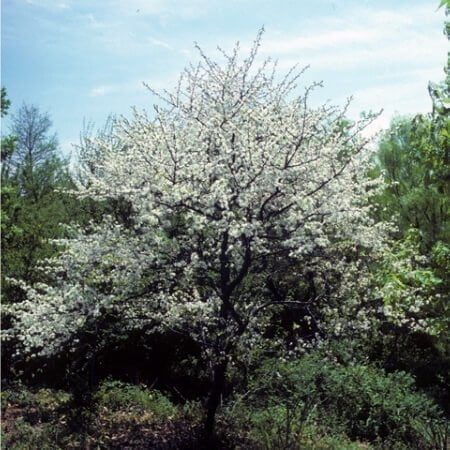
pic by Sally and Andy Wasowski via wildflower.org
the Hog Plum tree is also know as the Flatwoods Plum, Black Sloe Plum and Sloe Plum tree.
this wild plum is least cold-tolerant. it grows in the South, from Texas to North Carolina, to the Gulf. otherwise, it’s tolerant of shade/sun and various soils, as are most wild Plum trees.
i found no good remarks about eating the fruit fresh. making preserves is likely the best option.
Height: 15-20′
Fruit size: 3/4 to 1″
Grow As: shrub/hedge or single trunk tree
Plant zone: 8-9
Remarks: not cold-tolerant.
9. Hortulan Plum, Prunus hortulana
the Hortulan Plum tree is also known as the Wild Plum tree.
this is a widely dispersed Plum tree, and the largest of all North American wild plums! most commonly found in central / central north US (densest in Illinois, Indiana and Missouri).
white dots on the fruit make identification easy; this tree’s fruit matures from Sept – October. fruit flavor varies, like so many wild Plums! reviews of the fruit’s flavor: “very sweet,” “agreeable flavour,” and “not very palatable.” fruit flavor is hit & miss so find trees with sweet fruit and gather the scion!
Height: up to 30′
Fruit size: over 1″
Grow As: single trunk tree
Plant zone: 5-9
Remarks: the tallest wild plum tree; produces large edible fruit; rarely suckers; wide-ranging tree so it’s adaptable.

pic by Rick Webb via garden.org
10. Klamath Plum, Prunus subcordata
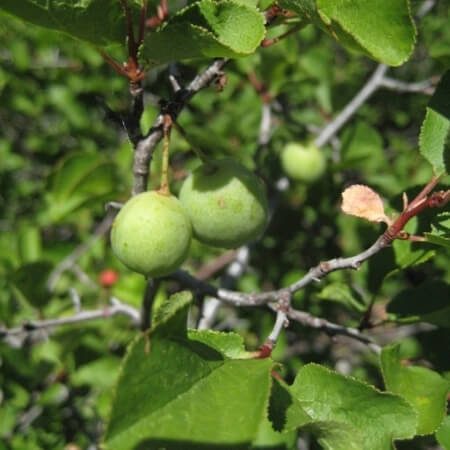
© 2009 Julie Kierstead Nelson via CalPhotos
calphotos.berkeley.edu
the Klamath Plum tree is also known as the Kellogg’s Klamath Plum, Oregon Plum, Pacific Plum, and Sierra Plum tree.
this specialist grows along the US West Coast. it grows in forests and near the ocean! it’s the only wild plum growing in Pacific US states, so identification is simpler. in August-September you can find good sized fruit, colored red / purple-red which also taste good!
Height: 15-20′
Fruit size: about 1+”
Grow As: shrub/hedge or single trunk tree
Plant zone: 6-9
Remarks: good fruit flavor; the only wild plum in Pacific US states;
As an Amazon Associate, HEPPY earns from qualifying purchases (paid link).
11. Mexican Plum, Prunus mexicana
the Mexican Plum tree grows like a cultivar (‘standard’) fruit tree: single trunk, and does not form thickets (it does not sucker). it’s a beautiful tree – rich and healthy leaf-growth and forms a nice shape.
the plum fruit’s taste is hit or miss. “varying palatability.” fruit color ranges from yellow, rose, lavender or purple. showy leaf-color in the fall. it’s an attractive and adaptive tree.
Height: 15-20′
Fruit size: about 1″
Grow As: single trunk tree.
Plant zone: 6-8
Remarks: does not sucker; attractive tree; gather scion from trees that produce flavorful fruit if fruit on your Mexican Plum tree is tart.
12. Murray's Plum, Prunus murrayana

pic via Benny J. Simpson's, Texas Native Shrubs
https://aggie-horticulture.tamu.edu/ornamentals/nativeshrubs/
the Murray’s Plum tree is also known as the Murray Plum tree.
“Murray plum is so rare that since its discovery in the Davis Mountains in 1928, no one has seen it with fruit.” now, that’s rare!
the ultimate wild plum specialist AND native to only Texas (like the Havard’s and Peachbush Plum trees). the tree grows in the Davis, Del Norte and Glass Mountains in West Texas (within the Trans-Pecos Mountain range).
highly heat and drought tolerant. distinguished by white, pink or red colored flowers.
Height: 6-15′
Fruit size: 1/2 to 3/4″
Grow As: shrub/hedge or single trunk tree
Plant zone: 7 may be the coldest (Northern) zone
Remarks: the rarest of all Plum trees; there’s no documentation of the fruit since it was first scientifically described; endemic to very small mountainous dry regions in the Trans-Pecos Mountains.
Unusual sources:
Flora of North America, Prunus murrayana
Benny J. Simpson’s, Texas Native Shrubs, Prunus murrayana
13. Oklahoma Plum, Prunus gracilis
the Oklahoma Plum tree is also known as the Sour Plum, and Sand Plum tree.
grows wild in central to south-central US. thicket-forming and not tall — excellent for hedgerow or windbreak. fruit is said to be “pulpy” and “poor eating quality as a fresh fruit.”
Height: up to 6′
Fruit size: 1/2 to 3/4″
Grow As: shrub/hedge
Plant zone: 5-9
Remarks: undesirable fruit; not easy to find for sale.
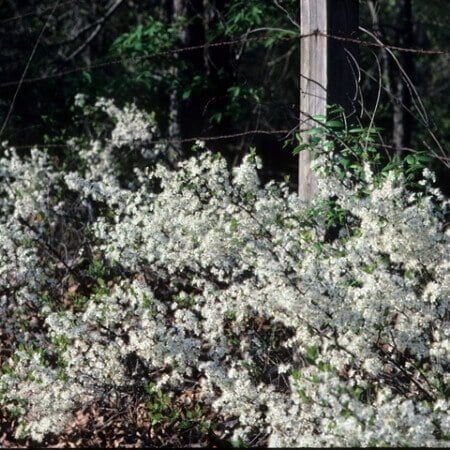
pic by Sally and Andy Wasowski via wildflower.org
14. Peachbush Plum, Prunus texana
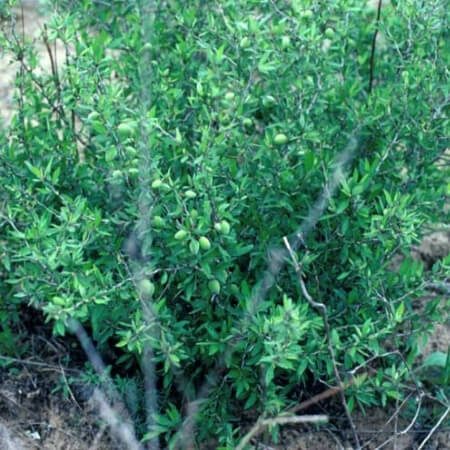
pic via Benny J. Simpson's, Texas Native Shrubs
https://aggie-horticulture.tamu.edu/ornamentals/nativeshrubs/
the Peachbush Plum tree is also known as the Texas Almond Cherry, Sand Plum, Texas Peachbush, Peach Bush, Peachbush, and Wild Peach tree.
another true specialist AND native to only Texas (like the Havard’s and Murray’s Plum trees). the Peachbush Plum tree grows in south-central Texas, in the Rio Grande Plains and Edwards Plateau.
highly heat and drought tolerant, it’s a short (dwarf) shrub with irregular branches. best identified by “young branches [that] are light grey and conspicuously covered with short, stiff hairs.”
it grows in at / below 2,000 foot elevation. this is far lower than the Havard’s Plum.
Height: conflicting information; perhaps up to 1/2 to 1″
Fruit size: 3′
Grow As: best as a shrub/hedge
Plant zone: 8 may be the coldest (Northern) zone
Remarks: extremely rare; endemic to a small mountainous dry region in the “Rio Grande Plains and Edwards Plateau“.
Unusual sources:
Flora of North America, Prunus texana
USDA, Journal of Agricultural Research, Nov. 10, 1913
Benny J. Simpson’s, Texas Native Shrubs, Prunus texana
15. Wild Goose Plum, Prunus munsoniana
the Wild Goose Plum tree is also known as the Big Tree Plum tree.
the Creek and Hortulan Plum trees are also called the “Wild Goose Plum.” however, the Creek, Hortulan and Wild Goose Plum trees have different scientific names (USDA PLANTS).
not too much is written about the Wild Goose Plum tree despite a wide distribution in the States! also, i see remarks on two trusted sites that the fruit taste good. “Thin skinned with a juicy aromatic flesh….” also, it produces a fruit colored yellow or orange! seems like this tree should be more common.
in the wild it grows as a multi-stemmed shrub / tree.
Height: up to 12′
Fruit size: 1 1/4″ (as in, over 1″!)
Grow As: shrub/hedge or single trunk tree
Plant zone: 5-9
Remarks: good fruit quality; produces a fruit that’s larger than most wild plums; produces an unusual colored fruit; a wild plum tree that grows wild across a wide range; and, not commonly sold. this tree ‘yells’ opportunity for sales (Framer’s Market, selling a niche tree, etc.).
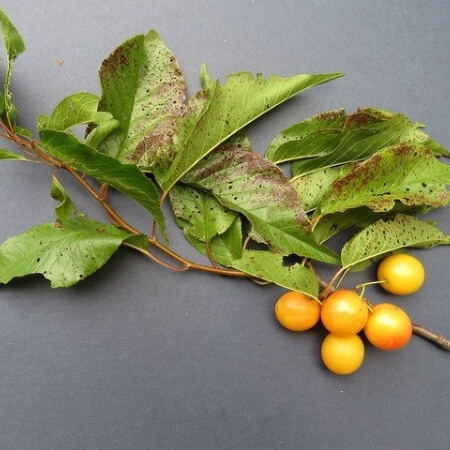
pic by Jeff D Hansen via kansasnativeplants.com
List of 15 Wild Plum Trees
Allegheny Plum, Prunus alleghaniensis
American Plum, Prunus americana
Beach Plum, Prunus maritima
Canadian Plum, Prunus nigra
Chickasaw Plum, Prunus angustifolia
Creek Plum, Prunus rivularis
Havard’s Plum, Prunus havardii
Hog Plum, Prunus umbellata
Hortulan Plum, Prunus hortulana
Klamath Plum, Prunus subcordata
Mexican Plum, Prunus mexicana
Murray’s Plum, Prunus murrayana
Oklahoma Plum, Prunus gracilis
Peachbush Plum, Prunus texana
Wild Goose Plum, Prunus munsoniana
________________________________________
YouTube channel (please subscribe)




